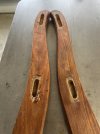With great advise from posts 1&2 I have taken the first chair apart. The original glue is hide glue. The tip to use steam worked great. I used a hand held steamer used to remove wrinkles. Wife bought it years ago and never used it. It now belongs to me.
My question this time is about the mortises. The ends are rounded. For some reason this surprises me. The sides are also sloped to accommodate the curved back. Should this type of mortise tell me anything about the chair, as in age?

My question this time is about the mortises. The ends are rounded. For some reason this surprises me. The sides are also sloped to accommodate the curved back. Should this type of mortise tell me anything about the chair, as in age?

